Intracellular Ca2+ regulating proteins in vascular smooth muscle cells are altered with type 1 diabetes due to the direct effects of hyperglycemia
- PMID: 20122173
- PMCID: PMC2829469
- DOI: 10.1186/1475-2840-9-8
Intracellular Ca2+ regulating proteins in vascular smooth muscle cells are altered with type 1 diabetes due to the direct effects of hyperglycemia
Abstract
Background: Diminished calcium (Ca2+) transients in response to physiological agonists have been reported in vascular smooth muscle cells (VSMCs) from diabetic animals. However, the mechanism responsible was unclear.
Methodology/principal findings: VSMCs from autoimmune type 1 Diabetes Resistant Bio-Breeding (DR-BB) rats and streptozotocin-induced rats were examined for levels and distribution of inositol trisphosphate receptors (IP3R) and the SR Ca2+ pumps (SERCA 2 and 3). Generally, a decrease in IP3R levels and dramatic increase in ryanodine receptor (RyR) levels were noted in the aortic samples from diabetic animals. Redistribution of the specific IP3R subtypes was dependent on the rat model. SERCA 2 was redistributed to a peri-nuclear pattern that was more prominent in the DR-BB diabetic rat aorta than the STZ diabetic rat. The free intracellular Ca2+ in freshly dispersed VSMCs from control and diabetic animals was monitored using ratiometric Ca2+ sensitive fluorophores viewed by confocal microscopy. In control VSMCs, basal fluorescence levels were significantly higher in the nucleus relative to the cytoplasm, while in diabetic VSMCs they were essentially the same. Vasopressin induced a predictable increase in free intracellular Ca2+ in the VSMCs from control rats with a prolonged and significantly blunted response in the diabetic VSMCs. A slow rise in free intracellular Ca2+ in response to thapsigargin, a specific blocker of SERCA was seen in the control VSMCs but was significantly delayed and prolonged in cells from diabetic rats. To determine whether the changes were due to the direct effects of hyperglycemica, experiments were repeated using cultured rat aortic smooth muscle cells (A7r5) grown in hyperglycemic and control conditions. In general, they demonstrated the same changes in protein levels and distribution as well as the blunted Ca2+ responses to vasopressin and thapsigargin as noted in the cells from diabetic animals.
Conclusions/significance: This work demonstrates that the previously-reported reduced Ca2+ signaling in VSMCs from diabetic animals is related to decreases and/or redistribution in the IP3R Ca2+ channels and SERCA proteins. These changes can be duplicated in culture with high glucose levels.
Figures

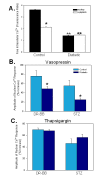

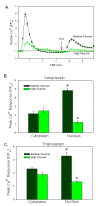

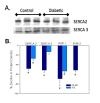
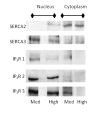
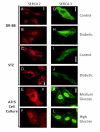

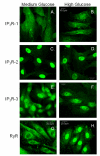
Similar articles
-
Nucleoplasmic calcium regulation in rabbit aortic vascular smooth muscle cells.Can J Physiol Pharmacol. 2003 Mar;81(3):301-10. doi: 10.1139/y03-005. Can J Physiol Pharmacol. 2003. PMID: 12733828
-
Berberine alleviates the cerebrovascular contractility in streptozotocin-induced diabetic rats through modulation of intracellular Ca²⁺ handling in smooth muscle cells.Cardiovasc Diabetol. 2016 Apr 12;15:63. doi: 10.1186/s12933-016-0382-9. Cardiovasc Diabetol. 2016. PMID: 27067643 Free PMC article.
-
Importance of Altered Levels of SERCA, IP3R, and RyR in Vascular Smooth Muscle Cell.Biophys J. 2017 Jan 24;112(2):265-287. doi: 10.1016/j.bpj.2016.11.3206. Biophys J. 2017. PMID: 28122214 Free PMC article.
-
Cellular and molecular effects of hyperglycemia on ion channels in vascular smooth muscle.Cell Mol Life Sci. 2021 Jan;78(1):31-61. doi: 10.1007/s00018-020-03582-z. Epub 2020 Jun 27. Cell Mol Life Sci. 2021. PMID: 32594191 Free PMC article. Review.
-
Abnormal cell calcium homeostasis in type 2 diabetes mellitus: a new look on old disease.Endocrine. 1999 Feb;10(1):1-6. doi: 10.1385/ENDO:10:1:1. Endocrine. 1999. PMID: 10403564 Review.
Cited by
-
Endoplasmic-reticulum calcium depletion and disease.Cold Spring Harb Perspect Biol. 2011 Jun 1;3(6):a004317. doi: 10.1101/cshperspect.a004317. Cold Spring Harb Perspect Biol. 2011. PMID: 21441595 Free PMC article. Review.
-
Smooth Muscle Ion Channels and Regulation of Vascular Tone in Resistance Arteries and Arterioles.Compr Physiol. 2017 Mar 16;7(2):485-581. doi: 10.1002/cphy.c160011. Compr Physiol. 2017. PMID: 28333380 Free PMC article. Review.
-
Calcium Channels in Vascular Smooth Muscle.Adv Pharmacol. 2017;78:49-87. doi: 10.1016/bs.apha.2016.08.002. Epub 2016 Oct 14. Adv Pharmacol. 2017. PMID: 28212803 Free PMC article. Review.
-
Diabetes alters intracellular calcium transients in cardiac endothelial cells.PLoS One. 2012;7(5):e36840. doi: 10.1371/journal.pone.0036840. Epub 2012 May 9. PLoS One. 2012. PMID: 22590623 Free PMC article.
-
Effects of streptozotocin and unilateral nephrectomy on L-type Ca²⁺ channels and membrane capacitance in arteriolar smooth muscle cells.Pflugers Arch. 2015 Aug;467(8):1689-97. doi: 10.1007/s00424-014-1604-1. Epub 2014 Sep 9. Pflugers Arch. 2015. PMID: 25196539
References
-
- Preis S, Hwang S, Coady S, Pencina M, D'Agostino RS, Savage P, Levy D, Fox C. Trends in all-cause and cardiovascular disease mortality among women and men with and without diabetes mellitus in the Framingham Heart Study, 1950 to 2005. Circulation. 2009;119:1728–1735. doi: 10.1161/CIRCULATIONAHA.108.829176. - DOI - PMC - PubMed
-
- Aronson D. Hyperglycemia and the pathobiology of diabetic complications. Adv Cardiol. 2008;45:1–16. full_text. - PubMed
Publication types
MeSH terms
Substances
Grants and funding
LinkOut - more resources
Full Text Sources
Medical
Research Materials
Miscellaneous

